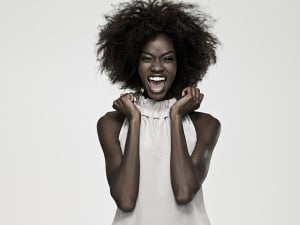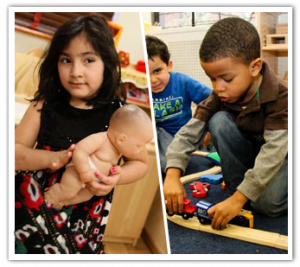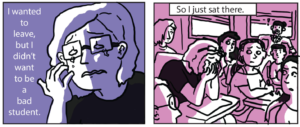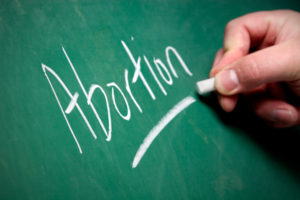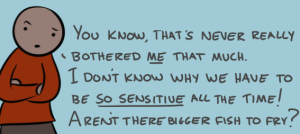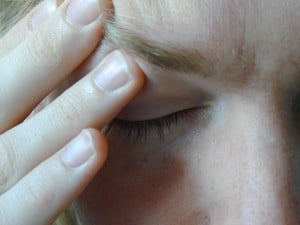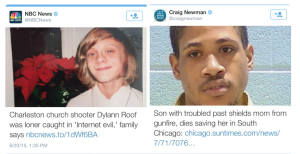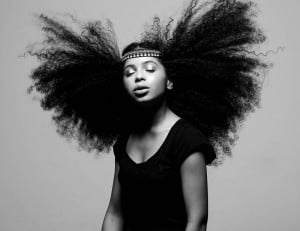
Source: HelloBeautiful
You know the difference between kitchen peas and kitchen peas, don’t you?
I’m not referring to the peas my grandma bought from the market and assigned me to shelling on Sunday mornings. Nor am I referencing the canned variety with the creepy green dude on the label.
I am talking about the tightest-of-the-already-tight tufts of hair that flank the base of the necks on many Black women. If you put your fingers directly behind your ears, ran them down the bumpy curves of your skull, and stopped right where your hairline began — right along those edges, for some of us as Black women, lay the sources of ridicule and reasons to hide.
Peas. Buckshots. Beady-bees. Ants. Nigga-naps. Nappy hair.
Yes, all of those are terms used to describe (read: disdain) the tight tufts that parallel my earlobes and flank the top of my neck. And I am not alone.
As Black women in America, we’ve been taught that aspects of our physical self are unacceptable in their natural forms. As such, they should be relegated to the privacy of our bathrooms — or better yet, transformed into tamed, relaxed, and otherwise invisible alternatives.
In a March 2014 interview about her best-selling novel Americanah (a brilliant read!), acclaimed novelist Chimamanda Adichie spoke about her views on Black women’s hair through the American lens. Interviewer and fellow word-wielder Zadie Smith read aloud an audience question about hair:
“So much of the commentary I’ve read about the book focuses on hair. The book is about so much more to me, including exile, identity, Blackness, African-ness, etc. How do you feel about people focusing on the hair issue, and not focusing on the bigger issues you address?”
I appreciated the honesty and weight of Adichie’s response.
“I think hair is a big issue; I absolutely do. Black women’s hair in particular.”
She went on to say:
“I don’t mind [the commentary]. People can write books about baseball, and people can intellectualize the discussion around baseball. So if you can do that, why not Black women’s hair, which has a history, which has political meaning, which is so deeply layered, and which I think the world doesn’t know enough about? Which is why when a woman wears her hair a certain way, she’s considered unprofessional, …she can’t work in consulting in New York City.”
In a separate interview, Adichie addressed the intersection of race and hair as follows:
“When I was growing up in Nigeria, I didn’t think much about hair, because there was no need to. I think the reason I started to think about hair [in the United States] is perhaps because I also discovered race. And I think both were linked.”
They are linked. And more than that, the strength of that link has created multi-tentacled offshoots of Blackgirl hair-isms, including intra-racial biases and judgments.
I mindfully and deliberately use the term Blackgirl because our hair consciousness and subsequent struggles do not begin in womanhood.
For most of us, it starts the moment we each sit between our mother or grandmother’s thighs to get our hair combed, and we first stare down the two-pronged road of shame and celebration.
The shame may show up in the form of words that we begin to recognize as bad: nappy, tough, unmanageable. And that road is unfortunately far more familiar than the other road that tells us to be proud — and to stay proud — of our hair for being exactly how it is.
Most of our mothers and grandmothers met the same shame in their girlhood days, and not wanting us to experience the levels of hurt they endured, saved us by straightening our hair.
Our hair first needs to look like that of a white male — short and very straight, especially around the edges. And then as we come into our womanhood, we graduate to the white female’s hair: still straight, especially around the edges, but longer now because we want to be beautiful and professional.
And in order to do so, we must have enough hair to go into a ponytail, and that ponytail should move. Otherwise, it’s more like a rabbit’s “cottontail,” which is apparently not appropriate for an environment where we are interacting with computer screens.
If we are ambitious and also want to feel beautiful, Black girls believe we must hide one of the very first things to show up when we present ourselves; the African-ness of our hair.
Some of us say that this transition is about manageability or versatility, but for others, it’s about a separation from our roots and a transition into a safer, more culturally appropriate space.
None of us are wrong, but all of us need to make this choice more consciously, or we’ll allow ourselves to be molded by the larger society, with our full permission.
Indeed, our transition to invisibility for the sake of appropriateness spans a lifetime. Here’s how I see it:
Infancy to Age 6
Message: It’s cute — with a bit of extra care.
Some of us get a pass here because our hair might still have a softness to it that doesn’t directly link us to the tight coils that identify us as being of African descent. Our parents can use castor oil and other baby hair preservers to keep our hair soft and acceptable.
For others, like me, with no passable hair stage, tight cornrows that literally raise your daughters’ eyebrows are a popular option. Maybe that’s because they’re “cute” and carry a cultural and historical reference that some of us gladly claim.
But maybe it’s also because it’s a safe alternative to an afro.
My aunt, still to this day, brags about being the only one in our neighborhood who could “catch” my hair. A simple wash, brush, and go was not enough — because I had Blackgirl hair. Afropuffs are only okay if they look soft and curly, not kinky like “regular” Blackgirl hair.
There was no social media to tell my mama and my aunt what people keep telling Beyoncé and Jay-Z, but the message was still the same and still powerfully clear: A white toddler can walk around with their hair simply clean and brushed. A Black toddler cannot.
Ages 7 to 12
Message: It depends.
At this stage, it may be more appropriate to press our hair than to perm it.
Back when I was in this age range, the cute-maker was the pressing comb. That magic wand was the weapon that kept our hair looking white (culture, not color!) and right for up to ten days.
But only if we sat still, ignored the steam and burns, and focused on how not to get our hair wet with rain, sweat, or any other killers of Whitegirl-looking hair.
Ages 13 to 16
Message: It’s time.
This is the rite of passage stage where you won’t likely get side-eyed by anyone in your community for perming your daughter’s hair too early. I guess the chemicals somehow get safer as we get older because now a Black girl can finally get her ultra-cute on with a perm.
At this stage, she can also rock a moderate weave (hair extensions). It won’t be Rapunzel length, but at least now she can perm her hair so that her weave and her real hair have a similar texture.
Now she can pretend to have Whitegirl hair, if she wants.
Also, she can be presentable for any school-related performances where photos will be taken — because there’s nothing worse than nappy hair in an otherwise beautiful picture.
Ages 17 through 20
Message: It’s on you.
This is the only stage I remember seeing more than a handful of young Black women with Blackgirl hair. I don’t mean the Blackgirl hair that involves loose, bouncy tendrils that are apparently both Black enough and safe enough to be unintimidating and appropriate. I don’t mean the curls that bless the box covers of almost all Black hair care products.
I mean Black African hair.
This is apparently the acceptable stage for a young Black woman to experiment.
She’s out of high school, perhaps finding herself, and therefore gets a conditional pass to explore all options, including braids, weaves, headwraps — and even her natural hair.
21 and Beyond
Message: It’s a matter of maturity.
At this stage, our society (including our own communities) sends a clear message: You had your fun. Unless you’re one of those creative types, you need to be presentable, which is interchangeable (during business hours) with professional.
You cannot have kinks and a peas-y kitchen and expect to be taken seriously by the dominant society.
You can’t be both ambitious and rebellious.
Because that’s the thing: Wearing your hair the way it grows out of your head is an act of rebellion. Not an act of nature, but a clear assertion of a radical, kiss-my-ass-America style rebellion.
This matter of maturity creates the pulse of the heart from which self-judgment beats. And that judgment shows up in our communication with each other as much as it does in our mirrors.
Speaking of which…
The Relaxed Vs. Natural Debate Dilemma
Read through the comments below any popular Black hair blogger’s YouTube video, and it’s a safe to bet that you’ll find one conscious sister or brother berating Black women who perm (chemically process) their hair.
Somehow, our years of shared shame about our kitchens kinks morphed into a space where some of us who choose to return to natural hair — or never left it — become the unsolicited voice of damnation to any of us who choose to chemically process our hair.
And so the peas in the kitchen continue to cause uproar.
Historically, the peas needed to disappear so we could be presentable, employable, potentially pretty, and less–well–different.
Nowadays, those pesky peas have become a source of inter-community battles between those who continue to perm their hair, and those who choose to return or stay natural.
But perhaps the power is neither in the perm, nor the peas. Maybe the power is in our willingness to choose for ourselves. And to explore whatever we choose from a place of honesty.
Today’s dialogue on Blackgirl hair, specifically the dialogue among Black people, might be more useful if we focused on why instead of what.
Perhaps we could be so bold as to question why natural hair is associated with spiritual and social consciousness. And why one woman needs another woman to believe whatever she believes. (Reminiscent of Christianity’s let-me-save-your-soul complex, isn’t it? But I digress.)
Maybe we should question whether the natural-haired sister who spends $100 dollars per week on hair products, and two hours per day on YouTube tutorials, just so her hair can “look good natural,” is any more conscious than the perm-and-go sister who enjoys the ease of her processed hair.
***
If we truly want to distance ourselves from the centuries of varied invisibility, we should seek a knowledge of self that nurtures confidence and freedom of choice.
We should look at the ways Black women are being marketed to and convinced of the need to purchase things — be they chemical “relaxers” or curl puddings — to be somehow better.
We should question whether this notion of hair manageability is about comfort and ease, dollars and cents — or if it’s just another effective means of separating us from one another.
We should explore and express ourselves through the results of self-inquiry, instead of the effects of self-doubt and societal pressure.
That may be the start of a movement away from the -isms and prisons and onto a healthier space.
That may just be a way to solve the issue of demonized kitchens and unconscious choice, and every woman’s right to rock her coif in whatever way suits her soul.
[do_widget id=”text-101″]
Akilah S. Richards is a Contributing Writer for Everyday Feminism. She is a six-time author, digital content writer, and lifestyle coach who writes passionately about self-expression, womanhood, modern feminism, location independence and the unschooling lifestyle. Connect with Akilah on Instagram, Tumblr, or her #radicalselfie e-home, radicalselfie.com. Read her articles.
Search our 3000+ articles!
Read our articles about:
Our online racial justice training
Used by hundreds of universities, non-profits, and businesses.
Click to learn more









